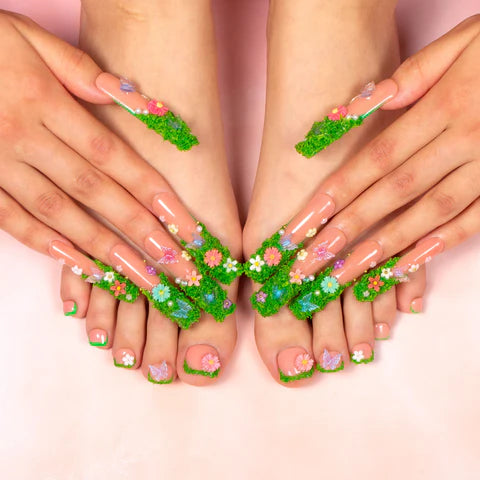
Why Are My Press on Nails Cracking?
Press-on nails offer a quick and stylish manicure without the need for a salon visit. But many users face a common problem: their nails start cracking too soon. It's frustrating to see your perfect manicure develop tiny fissures just days after application. This issue affects both newcomers and experienced users of press-on nails. Why does this happen, and how can you prevent it? In this article, we'll explore the reasons behind these annoying cracks and provide practical tips to keep your press-on nails looking great for longer. Read on to learn how to make your manicure last and avoid the disappointment of cracked nails.
Signs of Press-On Nail Damage
Press-on nails can show damage in various ways. Understanding these signs helps you identify problems early and take action to protect your manicure.

Types of Cracks in Press-On Nails
1. Micro-Cracks
These tiny, almost invisible lines often appear near the edges or tips of your press-on nails. You might need to look closely to spot them, but they're usually the first sign of trouble. Micro-cracks can indicate stress on the nail or poor adhesion.
2. Full Cracks
These are the more noticeable breaks that run across the nail. They might start at the tip and work their way down, or appear suddenly in the middle of the nail. Full cracks often mean the nail has been subjected to too much force or isn't flexible enough for your daily activities.
3. Spider Web Cracks
Sometimes, you might notice a network of small cracks spreading out like a spider web. This pattern often suggests that the nail has been repeatedly stressed from multiple angles.
What Your Cracked Nails Are Telling You
The location and pattern of cracks can reveal a lot about what's causing the problem:
- Edge Cracks: Often mean the nail is too small or wasn't applied correctly.
- Tip Cracks: Usually indicate that the nail is taking too much impact during daily activities.
- Center Cracks: Might suggest that the nail material is too brittle or that you're applying too much pressure.
This knowledge is key to preventing future damage and enjoying longer-lasting, beautiful nails.

What Press-On Nails Are Made Of
Press-on nails might look simple, but their composition plays a big role in how well they perform.
Materials in Press-On Nails
Most press-on nails are made from ABS (Acrylonitrile Butadiene Styrene) plastic. This material is chosen for its durability and ability to mimic the look of natural nails. Some higher-end brands use a blend of ABS and other plastics to improve flexibility.
Press-on nails come in various thicknesses. Thinner nails (around 0.2mm) offer more flexibility but may be prone to breaking. Thicker nails (up to 0.5mm) are more durable but can feel less natural.
The glue used to attach press-on nails is typically a cyanoacrylate-based adhesive. Some nails come with pre-applied adhesive strips for easier application.
How Materials Affect Nail Performance
The type of plastic and thickness of the nail determine how flexible it is. More flexible nails adapt better to your natural nail's movements, reducing the risk of cracking.
Thicker nails and harder plastics tend to be more durable, but they might crack if subjected to sudden force. Softer, more flexible materials may show wear more quickly but are less likely to crack outright.
The material and thickness also affect how natural the nails feel. Thinner, more flexible nails often feel more comfortable and natural, while thicker ones might feel more noticeable on your fingertips.
This knowledge of nail materials helps you pick the right press-ons for your needs. It also explains why some nails might crack more easily than others, even with proper care.

4 Reasons Your Press-On Nails Are Cracking
Press-on nails can crack for several reasons. Here are the most common causes and how to prevent them.
1. Picking the Wrong Nail Size
Using nails that are too small puts extra stress on them. When the press-on doesn't cover your entire nail, the edges take more force, leading to cracks. To get the right size, measure the width of your natural nails at their widest point. Choose press-ons that match or are slightly wider than this measurement. If you're unsure, it's better to go for a larger size and file it down to fit.
2. Putting Too Much Pressure on Your Nails
Everyday activities can put a lot of stress on your press-ons. Typing on keyboards, opening jars, or scrubbing while cleaning can all cause damage. To reduce pressure, try using the pads of your fingers instead of the tips when possible. For cleaning tasks, wear gloves to protect your nails. It's also helpful to take breaks from repetitive activities that stress your nails.
3. Making Mistakes During Application
How you put on your press-ons matters. Common errors include not cleaning your natural nails properly, using too much or too little adhesive , and not pressing the nails down long enough. For better application, start by cleaning and buffing your natural nails. Apply a thin, even layer of glue, then press each nail firmly for at least 30 seconds. After application, wait an hour before doing any tasks with your hands.
4. Dealing with Environmental Issues
Your surroundings can affect your press-ons too. Extreme temperatures can make the nails brittle, while chemicals in cleaning products can weaken the adhesive. To protect your nails, avoid very hot water when washing your hands and wear gloves when using cleaning products. Applying a clear top coat can also add an extra layer of protection.
These strategies will help reduce the chances of your press-on nails cracking. Good care of your press-ons keeps your manicure looking great for longer.

When Press-On Nails Are Flawed From the Start
Sometimes, the problem isn't how you use your press-on nails, but rather the nails themselves. Material and manufacturing issues can lead to cracking, no matter how careful you are.
Poor Quality Materials
Not all press-on nails are made equal. Cheaper nails often use lower-quality plastics that are more prone to cracking. These materials might be too brittle, lacking the flexibility needed to withstand daily wear and tear. Higher-quality nails use better plastics that can flex without breaking, reducing the risk of cracks.
Manufacturing Inconsistencies
The way press-on nails are made can also affect their durability. Inconsistencies in the manufacturing process can create weak points in the nails. For example:
- Uneven thickness: Parts of the nail might be thinner than others, creating stress points where cracks can start.
- Air bubbles: Tiny air pockets trapped in the plastic during production can weaken the nail's structure.
- Poor molding: If the nails aren't molded correctly, they might have rough edges or uneven surfaces that are more likely to snag and crack.
These manufacturing defects aren't always visible to the naked eye, but they can significantly impact how long your press-on nails last before cracking.
To avoid these issues, it's worth investing in reputable brands known for quality control. While they might cost more upfront, you'll likely save money in the long run by not having to replace cracked nails as often.

How to Stop Your Press-On Nails from Cracking
Want to keep your press-on nails looking perfect? Here are some practical tips to prevent cracks and extend the life of your manicure.
1. Get the Right Size
Always choose press-on nails that are slightly larger than your natural nails. It's easier to file down a bigger nail than to deal with one that's too small. Use a gentle nail file to shape the sides and free edge until they match your natural nail shape perfectly. This custom fit reduces stress on the nail and prevents cracks.
2. Perfect Your Application Technique
Applying your press-ons correctly is crucial. Start with a thin, even layer of nail glue. Too much glue can create air pockets, while too little won't provide enough hold. When placing the nail, align it carefully with your natural nail, starting at the cuticle and pressing down firmly towards the tip. Hold each nail in place for at least 30 seconds to ensure a strong bond.
3. Care for Your Nails
Treat your press-ons like you would your natural nails. Apply a strengthening base coat before putting on your press-ons to protect your natural nails. Once your press-ons are on, use a clear top coat every few days to add an extra layer of protection against cracks and chips.
4. Adjust Your Daily Habits
Small changes in your routine can make a big difference. Use your knuckles instead of fingertips to press buttons or open containers. Invest in touch-screen friendly gloves for texting in cold weather. When typing, keep your nails parallel to the keyboard to reduce impact. For household chores, wear rubber gloves to protect your nails from water and harsh chemicals.
Keep Your Press-On Nails Crack-Free
Press-on nails can be a great way to get a stylish manicure quickly, but cracking can be a frustrating problem. By understanding the causes of cracks and following the tips in this article, you can significantly extend the life of your press-on nails. Remember to choose the right size, apply them correctly, and protect them from daily wear and tear. Don't forget that the quality of the nails themselves matters too. With proper care and attention, you can enjoy beautiful, long-lasting press-on nails without the disappointment of premature cracking. Give these tips a try and see the difference in your next manicure!


